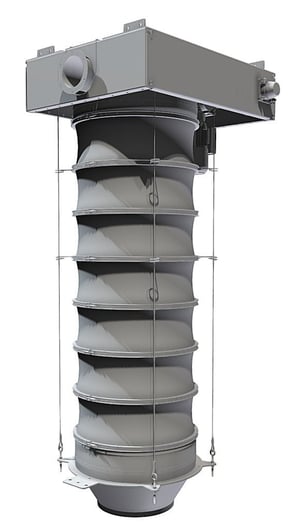Vortex Loading Spout vs Alternatives
Craig Rattos
The Power of Comparison | Vortex Loading Spout vs. Alternatives
When evaluating a loading spout, it's important to accurately compare one option to another. Here's some help to do just that!
Four cable hoist drive systems have one or two additional lifting cables, compared to traditional two and three cable hoist drive systems. This creates a more even weight distribution across a greater number of lifting cables, resulting in less stress on each lifting cable, which in turn reduces cable wear, increases cable service factor and prolongs cable service life. Vortex lifting cables are breakage-resistant. Individually, they can withstand up to 400 lb | 180 kg of tension. Collectively, a spout’s four lifting cables provide total breakage resistance of 1,600 lb | 725 kg of tension.
With many other loading spout options, a braking system must be sourced separately from the spout’s motor. The Vortex Loading Spout is factory supplied with an integral braking system, as a standard.
Many alternative loading spouts feature standard pulleys as part of their hoist drive systems. Often, these standard pulleys have rough edges which cause the lifting cables to fray. To eliminate cable fraying, the Vortex Loading Spout features two CNC-machined three-piece pulleys with rounded edges and precision cable grooves. This design prevents cable failure and other costly downtime for cable repair. Vortex is confident in the durability of their lifting cables, compared to other industry suppliers. So much so that Vortex Lifting Cables carry a 10-year warranty for wear, tear and workmanship. With less cable wear comes reduced maintenance cost, which allows for more efficient loading operations. In other loading spout options, fabricated pulley grooves can be inconsistent, which can cause the lifting cables to bind or overlap. This results in poor lifting performance, accelerated cable wear, spout imbalances and backlash. To address this concern, the Vortex Loading Spout’s CNC-machined pulleys are also designed with precision cable grooves to ensure smooth, balanced spout extensions and retractions.
Many alternative loading spouts feature inner and outer support rings which are fastened together using rivets, nuts, bolts and/or screws. In order to thread these fasteners, punctures must be made in the outer sleeve material. This creates vulnerable areas where the outer sleeve can cut, tear or experience other forms of failure early on in the spout’s lifecycle. To resolve this issue, Vortex’s high performance clamping method eliminates punctures in the outer sleeve material. Also, over time, the mechanical fasteners used in alternative loading spout designs can break and/or loosen, allowing them to fall away into the material load. To eliminate this potential source of foreign metal fragment contamination, the Vortex Loading Spout’s high performance clamping method rids the inner support rings of exposed mechanical fasteners.

Many alternative loading spout choices incorporate eyebolts to guide the sleeve support rings during spout extension/retraction. The primary disadvantage to eyebolts is their maintainability. If either the lifting cables or the outer sleeve must be replaced, eyebolts must either be:
- removed from the sleeve, which is challenging while the lifting cables are still connected; or,
- physically distorted (i.e. “opened”) in order to free the sleeve from the lifting cables. To resolve this maintainability issue, the Vortex Loading Spout incorporates four spiral-shaped cable guides along the circumference of each outer support ring. The primary advantage of spiral guides over eyebolts is that the lifting cables and/or the outer sleeve can be removed without having to manipulate the spiral guides. The lifting cables can be extracted from the spiral guides while the guides remain connected to the sleeve support rings.
When using u-bolt and nut harness guides in food grade applications, either of the fasteners can break and/or loosen, allowing them to fall away into the material load. To eliminate this potential source of foreign metal fragment contamination, machined steel pegs are welded to the outside of each stacking cone to replace the standard u-bolt and nut harness guides. An added benefit to steel pegs is they reduce the number of crevices and pockets where materials can become lodged as they pass through the spout. This brings ease to sanitation procedures.
Craig Rattos
Blog posts
Related Articles.
Craig Rattos
Flow Control Valves & Much More!
Understanding the Dual Role of Flow Control Valves| Diverters and Slide Gates
Flow Control Valves,...

Leave a Comment